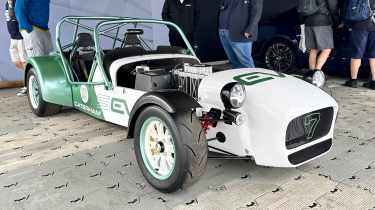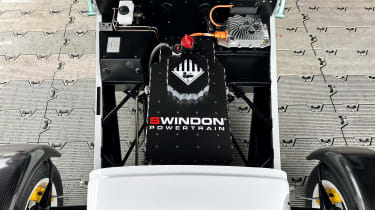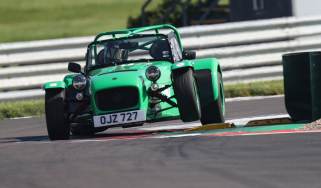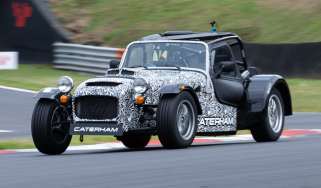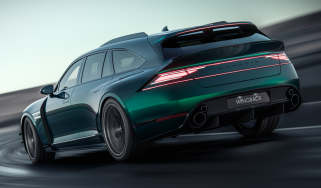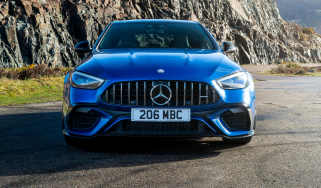The Caterham EV Seven is an electric car for track days
As the Caterham Seven enters its 50th year, the British marque has given us a glimpse at its electric future
‘We don’t have a queue of people wanting to buy an EV Seven.’ It’s a line I’ve heard a number of times from Bob Laishley, Caterham’s CEO. However, since the company’s announcement in late May that it was building an EV Seven to help development of the EV drivetrain for its soon to be revealed, all new sports car, interest in an electric Seven has spiked.
A battery electric drivetrain and the lightweight Seven have been considered incompatible thus far, yet in its efforts to understand electrification, what is required and what is possible, Caterham has developed an EV Seven concept with long-time engine partner, Swindon Powertrain. At the outset, Caterham was very conscious of staying as true to its guiding principles as possible: ‘Lightweight, simple, fun to drive,’ is a Laishley mantra.
Arriving at Swindon Powertrain’s factory, the sound of a four-cylinder engine being worked on a dyno drifts from the building that it has occupied for over 50 years. The company has a long history of internal combustion excellence: just last year its engine powered Tom Ingram’s BTCC winning Hyundai i30N, and it supplied the 250bhp Vauxhall engine for the Caterham Seven JPE. Yet perhaps surprisingly, Swindon Powertrain embraced electrification some years ago. The catalyst was when Swindon’s MD, Raphaël Caillé, drove a Tesla Model S. He describes it as a revelation that made him realise that the company had to embrace electrification or become a mere fettler of museum pieces. It has now developed its own drivetrain components and battery technology and has been designing, manufacturing and producing electric vehicles an bicycles for getting on for five years.
‘Building a Seven that’s capable of a Sunday morning drive is achievable with current battery technology but the challenge is for track use where the energy consumption is greatly increased,’ says Laishley. So, rather than chase range or outright performance, the EV Seven concept focuses on delivering track day performance, specifically being able to cope with a 20-15-20 cycle: that’s 20 minutes of track driving, 15 minutes of charging and another 20minutes of track driving.
This ‘saw tooth’ charging, with rapid discharge and recharging, is the most difficult for a battery to cope with and to manage the heat, Swindon is developing a bespoke, immersion cooled battery pack. Inside, the cells are directly surrounded by dialectic fluid and this is circulated through radiators to manage cell temperature, much as coolant is circulated in an IC engine to control engine temperature.
This track day duty cycle means that the EV Seven isn’t over burdened with battery mass. It has been specified to match the performance characteristics of the Seven 485 SV with its 234bhp 2-litre Ford Duratec engine and produces 240bhp at 9000rpm and instantaneous peak torque of 184lb ft (250Nm). The battery is rated at 51kWh and can take charge speeds of up to 152kW while having a useable capacity of about 40kWh, safely allowing the battery pack to withstand rapid discharge in demanding track use and rapid charging without causing premature degradation.
Swindon has 3D scanned a Seven and uploaded it to CAD, allowing it to explore packaging opportunities and identify potential issues: accommodating the steering column was a bit of a challenge. The battery pack fits in the space under the bonnet and in the transmission tunnel of the wide-bodied ‘series five’ SV chassis, while the EDU (electric drive unit) - a bespoke version of Swindon Powertrain’s established ‘E Axle’ – fits in the space normally occupied by the differential. There’s a slight compromise here, the passenger seat being mounted slightly further forward to free up a little more space.
This layout produces very similar weight distribution to the 485 SV, within a couple of per cent in fact, and Caterham says the mass of the two cars is only 70kg apart. The numbers don’t quite add up; Caterham says the 485 SV weighs 626kg whereas the website says its 560kg. Whatever the reality, an EV Seven would currently weigh just under 700kg. On the upside, as battery technology improves, as it inevitably will, the mass will go down, and Laishley offers further good news: ‘Looking at the job Swindon have done, we could package it in the smaller chassis in the future.’
Despite the extra mass carried by the EV Seven, it’s projected that the instant torque delivery of its powertrain – 184lb ft from zero rpm - will largely offset this from a standing start. It’s predicted that the EV Seven will deliver a 0-60mph time of about 4.0 seconds, compared with 3.4sec for the 485 SV, while the lack of gearchanges will help keep its acceleration close up to 100mph.
Lightweight, simple, fun to drive? An EV Seven that’s close to 700kg is not that light but it’s still about 400kg lighter than an Alpine A110 and, for context, less than half the weight of the recently announced MG Cyberster (1850kg). So in the EV landscape, an electric Seven would still be a lightweight car, especially as battery weight is only going down. Simple? It’s in the nature of a battery electric drivetrain, though here it also means minimal driving aids, so no electronic traction or stability control, and no regenerative braking either.
Fun to drive? It won’t have the bark of four-cylinder engine or the interaction of a manual gearbox but it will feel punchy, and with the right throttle characteristics, it could be fun. The drive unit will come with a limited slip differential and the instant torque and linear, predictable delivery of an EV powertrain could make the EV Seven even more controllable generally, on the limit and in oversteer. To see what it might be like, Caterham weighted up a regular Seven to almost 700kg and with the projected EV distribution and spent a day pounding around Snetterton. Against expectation in some quarters, the car needed only minor adjustments to deliver the character of a regular Seven, so Caterham now has a chassis set up ready to go.
We look forward to driving it, and the opportunity might come quite quickly, as Caterham plans to run it up the hill at the Goodwood Festival of Speed in July. How soon might we see an EV Seven in production? ‘We don’t have plans to put EV Seven into production at this stage,’ says Laishley. ‘It’s a test bed to see how well an EV powertrain works for our customers’ specific use cases. The right time will be when we can make a business case for it.’
Caterham EV Seven specs
| Engine | Bespoke Swindon HPDE E Axle |
| Battery | 51kWh (40kWh usable) |
| Charging | Up to 152Kw DC fast charge |
| Power | 240bhp |
| Torque | 184lb ft |
| Weight | <700kg |
| 0-60mph | 4sec (est) |
| Power-to-weight | c340bhp/ton |
| Top speed | 130mph (est) |

